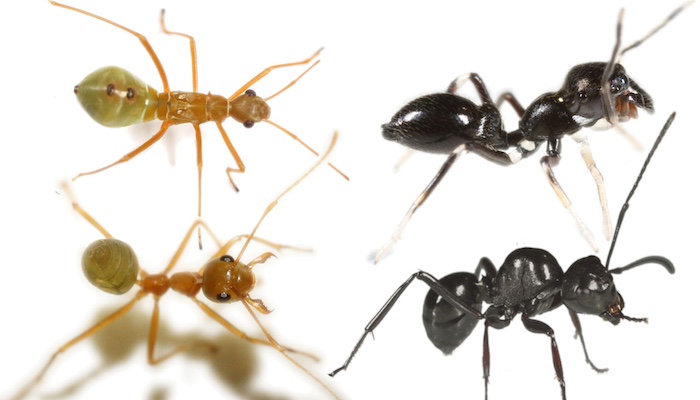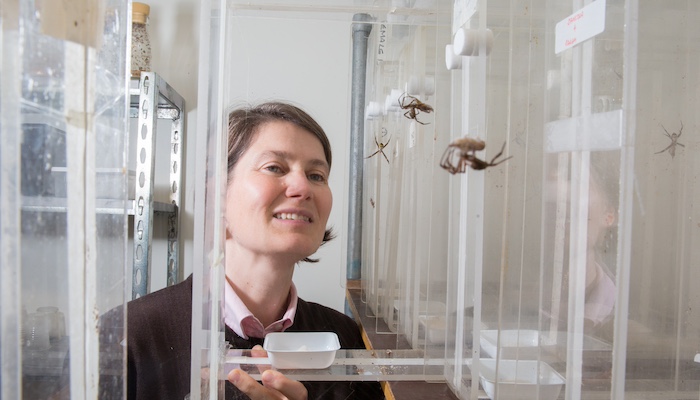New research published in Biology Letters this month investigates the evolutionary reasons why some spiders and insects have evolved to closely mimic ants in appearance, while others seem only to have made a half-hearted attempt.

Carbon copy: Both insects and spiders can convincingly copy ants. An ant-mimicking insect, Alydid species, is at top left, directly above the ‘real’ ant Oecophylla smaragdina. At top right, the black ant-mimicking spider Myrmarachne macleayana is compared to the ‘real’ ant below, Polyrhachis robsoni. Photo: Jim McLean.
Evolutionary biologist Dr Jim McLean and behavioural ecologist Professor Mariella Herberstein from Macquarie University’s School of Natural Sciences compared the bodies of 106 different species of ant-mimicking spiders and insects from the east coast of Australia.
“Ants don’t have many predators because they bite, sting and swarm to defend each other and taste awful – so it’s not surprising that plenty of spiders and insects have evolved to look like them,” says Professor Herberstein.
The scientists expected that ant-mimicking spiders would be less likely to look like ants than ant-mimicking insects, because their basic morphology (body structure) is so different.
All insects – ants included – have six legs arranged in three pairs and three main body segments: head, thorax and abdomen.
Spiders are arthropods, however, with eight legs arranged in four pairs, and only two body segments, the abdomen and cephalothorax, so need to adapt their appearance to a far greater extent to look like an ant.
But a lot of species could at best be described as half-hearted ant mimics. They might incorporate some morphological and colour elements that are reminiscent of an ant, but they would get no more than a two-star rating on Amazon.
“In this paper, we tested the idea that if you are not an ant, it should not be easy to evolve an ant’s body shape, because of morphological constraints that prevent you from attaining perfection,” says Professor Herberstein.
“Brilliantly, spider and bug mimics offer the perfect comparison to test this idea; spiders should have a much harder time to mimic ants compared to bugs.”
But the data didn’t support the hypothesis; spiders and bugs were equally capable of being almost-perfect ant mimics – but were also just as likely to be unconvincing low-level mimics.
Smooth operators
“The results surprised us,” says Dr McLean. “We found that the most accurate spider mimics are almost as good as the most accurate insect mimics. We had to consider other evolutionary explanations for the many ant-mimicking spiders that were not accurate.”
Professor Herberstein said some spiders are extraordinarily proficient at mimicing ants.
“There are many stunning examples of ant mimicry among spiders and bugs, some so convincing even Jim and I sometimes struggle to tell them apart from ants, and we look at them all the time,” says Professor Herberstein.
“But a lot of species could at best be described as half-hearted ant mimics. They might incorporate some morphological and colour elements that are reminiscent of an ant, but they would get no more than a two-star rating on Amazon,” she says.

Shape sorting: Professor Mariella Herberstein helped to measure spider and ant body shapes for this research into mimicry.
Delving deeper into the data, the researchers found that spiders tended to be worse mimics than insects when viewed from the side than from above.
“This could be because the main predators of spiders are birds and wasps, which identify their prey from above while flying,” says Dr McLean.
But that doesn’t explain the wide range in accuracy of ant-mimics in both spiders and insects, he says.
“Despite having two main body parts instead of three, some spiders evolved to be almost indistinguishable from ants; while many insects without that body-shape constraint are poor mimics."
Trade-offs
The authors said the study shows that because body shape isn’t a restriction, there must be other evolutionary factors at play.
“There may be trade-offs for imperfect mimicry, such as avoiding animals that prey on ants or making it easier for spiders to identify their own species for mating,” says Dr McLean.
Looking too much like an ant can even be a disadvantage, he says.
“Some spiders with thinner ant-like abdomens have reduced fertility. Smaller spider bodies also have less power for movement and may even have reduced brain size.”
Imperfect mimics may even be an example of evolutionary lag – meaning they are part-way along the evolutionary process, Dr McLean says.
“Our results support the idea that evolutionary constraints are not the reason for imperfect mimicry; given strong enough selection pressures and sufficient time, most species can overcome evolutionary constraints to convincingly copy another organism.”
Dr Jim McLean is an evolutionary biologist in the School of Natural Sciences.
Professor Mariella Herberstein is a behavioural ecologist in the School of Natural Sciences.



